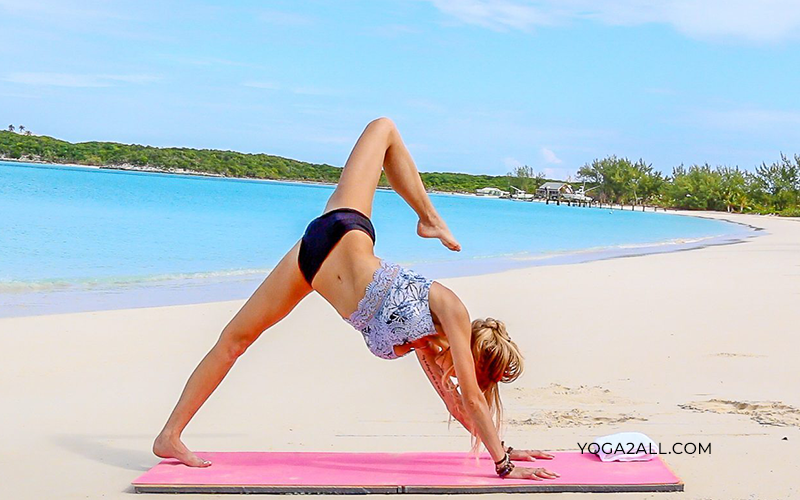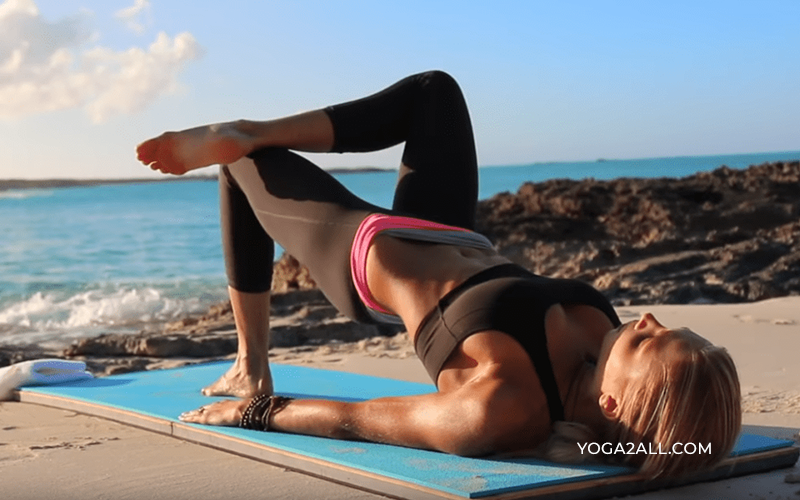
Yoga has mental and physical benefits. On its physical level, yoga mainly helps you improve flexibility. It provides you strength, balance as well as endurance. Almost all exercises have been proved to help people fight against depression, feel good and live better life, so yoga is not an exception.
A study has been conducted from Duke University Medical Center, which was suggested that Yoga could benefit those people who are suffering from anxiety, muscle pain, depression, schizophrenia, sleep problem and other psychiatric conditions. At the outset, you should know what are the benefits of yoga and what you can gain of this wonderful practice. After reading this page carefully, you will be able to understand the various types or styles of yoga and its benefits for physical and mental well-being.
- Mahabharata defines, the aim of Yoga is the experience of Brahman/Atman/Soul or pervading all things.
- Patanjali’s Yoga Sutra defines, the aim of Yoga is a state of permanent peace and cessation of the perturbations of mind.
- LIBERATION / MOKSHA is the ultimate aim of YOGA, according to the philosophical and theological system.
Apart from the spiritual freedom and peace, yoga can alleviate different health problems, reduce stress and make the spine supple in contemporary times. Yoga is widely used as a complete therapy and exercise for mind and body.

History Of Yoga
YOGA may have Pre-Vedic origin. Many valuable things discovered at Indus Valley civilization earlier denoted common poses of YOGA and meditation. Many people think that philosophical schools of Hinduism, Buddhism and Jainism had taken the philosophical system of yoga for their divine purposes. The system of YOGA and its importance has adopted by educated Western public in the mid 19th century with other topics of Indian philosophy.
- According to Zimmer, yoga is a part of Pre-Vedic heritage, which also includes Jainism, Samkhya and Buddhism.
- In accordance with White, the word ‘YOGA’ first used in the Rig Veda and YOGA is discussed in the Upanishads many of which predate Patanjali’s sutras. But the actual term ‘YOGA’ was first used in the ‘KATHA UPANISADA’, where the word ‘YOGA’ and ‘Meditation’ used in Brihadaranyaka Upanishad.
Mahabharata defined ‘YOGA’ mean ‘a divine chariot that carried him upward a burst of light to and through the sun, and to the heaven of Gods’.
- The term ‘YOGA’ widely used as a steady control of sense, which cessation of mental activity, leads to the supreme state. In the Bhagavad Gita (Song of Lord) used the term ‘YOGA’ in a variety of ways. It introduced three types of yoga namely:
- Karma Yoga – The Yoga of Action
- Bhakti Yoga – The Yoga of Devotion
- Jnana Yoga – The Yoga of Knowledge
In the chapter 2 of the Bhagavad Gita (Song of the lord) God Krishna explained to Arjuna about the importance of yoga as practiced in daily life.

Benefits of Yoga / Benefits of Asana
In West, the term YOGA widely used and associated with Hata Yoga and various Asana or Yoga Poses, as a form of exercise. Where yoga poses have been using purely as a form of exercise for the profound benefit of mental, physical and spiritual awareness.
- Yoga improves musculoskeletal and mental health, and prevent different disease, such as Asthma, Back pain, Spinal pain, Diabetes and so on. Regular Yoga practice increases brain GABA levels, improves mood and anxiety.
- Yoga is good for people suffering from heart disease.
- Yoga prevents and reduces high blood pressure, improves symptoms of heart failure.
- Yoga enhances cardiac rehabilitation, decreases cardio vascular risk factors.
- Yoga can decrease depression, insomnia, pain, fatigue and increase anxiety.
- Yoga also shows a positive effect on sleep anxiety.
- Yoga improves quality of life and improves spiritual growth for cancer patients.
- Yoga is very helpful as a treatment for schizophrenia and improves health related quality of life. Yoga is good for sports injury.
- For women during menstruation, for pregnant women, breathing exercise, meditations are very good and helpful to stay healthy.
- Yoga can be helpful for children and adolescents, either as a form of physical exercise or improving mindfulness and stress relief.
The three main aim of Hata Yoga are:
- Exercise – Workout
- Breathing – Pranayama
- Meditation – Dhayan

Hata Yoga is the foundation of all yoga styles. It is associated with postures / asanas, pranayama, breathing practices, meditation and kundalini yoga to achieve self-realization.
Yoga Poses – Yoga Postures – Yoga Asanas – Yoga Styles – Yoga Types
| Adho Mukha Svanasana | Kriya Yoga | Pashimottanasana |
| Awkward Chair Pose | Karma Yoga | Pincha Mayurasana |
| Agni Yoga | Kundilini Yoga | Feathered Peacock |
| Anusara Yoga | Karnipidasana | Forearm Stand |
| Anu Yoga | Knees to Ears Pose | Rocket Yoga |
| Anand Yoga | Ear Pressure Pose | Raja Yoga |
| Astanga Vinyasa Yoga | Laughter Yoga | Salamba Sarvangasana I |
| Bhakti Yoga | Mysore Yoga | Supported Shoulder Stand |
| Bikram Yoga | Mysore Style Yoga | Sivananda Yoga |
| Bando Yoga | Maha Yoga | Siddha Yoga |
| Baddha Konasana | Marichyasana II | Salamba Sirsasana I |
| Bhujapidasana | Spinal Twist variation | Supported Headstand |
| Chakrasana | Natarajasana | Salamba Sirsasana II |
| Chair Yoga | Dancer’s Pose | Supported Headstand |
| Cardiac Yoga | Natarajasana | Sherri Baptiste Asana |
| Dhanurasana | Dancer’s Pose variation | Siddhasana |
| Dream Yoga | Naked Yoga/Nude | Adept`s Pose |
| Dog Yoga | Nagna Yoga | Perfect Posture |
| Dhan Yoga | Nauli (Abdominal Exercise) | Supta Bhekasana |
| One-Legged Crow Pose | Naam Yoga | Sleeping Frog |
| One-Legged Head Pose | PiYo Yoga | Sural Sahabad Yoga |
| One-Foot Posture | Pranava Yoga | Tadasana (variation) |
| Forest Yoga | Padangustha Dhanurasana | Mountain Pose variation |
| Ganda Bherundasana | Big toe in bow pose | Tolasana |
| Halasana | Padmasana (Lotus Pose) | Scale Posture |
| Hatha Yoga | Revolved Head to Knee | Balance Pose |
| Iyengar Yoga | Parivrtta Janu Sirsasana | TriBalance Hot Yoga |
| Integral Yoga | Parivrtta Trikonasana | Trul Khor Yoga |
| Jivamukti Yoga | Revolved Triangle Pose | Taoist Yoga |
| Kum Nye Yoga | Back-stretching Posture | Tri Yoga |

Other Yoga Styles
| Urdhva Dandasana | Utthita Hasta | Vrksasana |
| Upward Staff Pose | Raised Big Toe-to-Hand | Tree Pose |
| Urdhva Kukkutasana | Vamadevasana II | Yoganidrasana |
| Lifted Rooster Pose | Vasisthasana | Yogic Sleep |
| Urdhva Muhka Uttanasana | Side Plank Pose | Yoga for synthesis |
| Upward-Face Stretch Pose | Virabhadrasana I | Vini Yoga |
| Urdhva Padmasana | Virbahadrasana II | Zen Yoga |
| Extended Lotus Headstand | Virbahadrasana III | Warrior I, I and III Pose |
You May Also Like:
Yoga Improves Brain Function I Yoga for Back Pain I Yoga for Spinal Pain I Yoga for Diabetes I Yoga Improves Mood I Yoga Reduces Anxiety I Yoga for Depression I Yoga for Schizophrenia I Yoga Improves Quality of Life I Yoga for Sports Injury I Yoga for Menstruation I Yoga for Pregnant Women I Yoga for Children I
Read More: Yoga Therapy



Nice post, looking forward for your next post. Kaberi Sharma
Thanks Kabari for your comment, your suggestions are cordially accepted for the future improvement of this blog.
hey, nice post and keep updating another topics, waiting………
Thanks reg for your comment